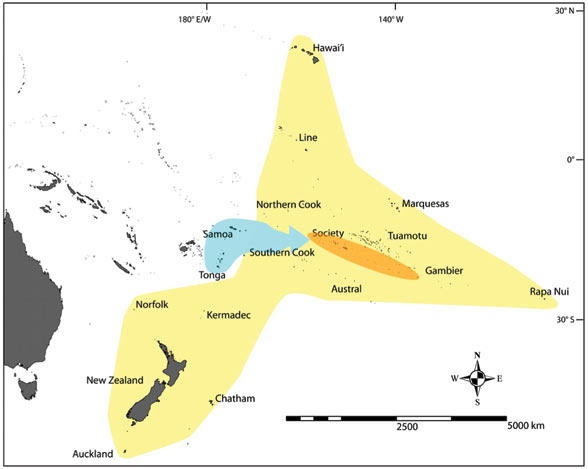Polynesian colonization was sudden and swift
April 21st, 2011 | by Malamalama Staff | Published in Research News | 1 Comment

New research indicates human colonization of Eastern Polynesia took place much faster and more recently than previously thought, University of Hawaiʻi at Mānoa anthropologist Terry Hunt reports. Polynesian ancestors settled in Samoa around 800 BC, colonized the central Society Islands between AD 1025 and 1120 and dispersed to New Zealand, Hawaiʻi and Rapa Nui and other locations between AD 1190 and 1290.
Hunt was part of an international team that applied improved radiocarbon dating techniques and equipment to more than 1,400 radiocarbon dated materials from 47 islands. Their model considers factors such as when a tree died rather than just when the wood was burned and whether seeds were gnawed by rats, which were introduced by humans.
Improved vessels and favorable winds resulting from frequent El Niño conditions probably contributed to the unusually rapid spread to hundreds of islands across an ocean area the size of North America, the team writes in the Feb. 1, 2011, Proceedings of the National Academy of Sciences.
Late and rapid dispersals explain remarkable similarities in artifacts such as fishhooks, adzes and ornaments across the region. The condensed timeframe suggests assumptions about the rates of linguistic evolution and human impact on pristine island ecosystems also need to be revised.
Hunt first recognized how indiscriminate samples excavated on Rapa Nui (Easter Island) could skew radiocarbon dating results.
Read the PNAS article. More on Hunt’s summer field schools on Rapa Nui in the January 2005 issue of Mālamalama.
Tags: anthropology, archaeology, Hawaiian, Pacific Islands and Australia, UH Manoa, Vol. 36 No. 2

December 3rd, 2011at 12:50 pm(#)
Great work explains allot about the similarities with polynesian cultures